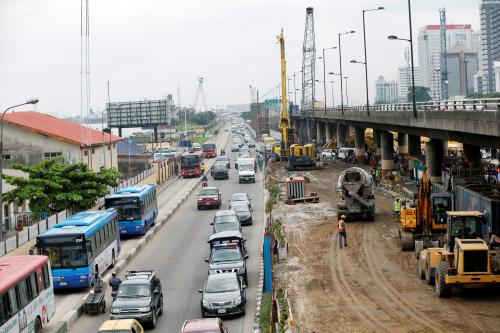At the Third United Nations International Conference on Financing for Development in 2015, policymakers called for the growth of and support for domestic resource mobilization to enhance development financing efforts. New areas for infrastructure financing in particular are emerging, as shown in a 2015 study on current sources of infrastructure financing in Africa. Indeed, in recent years, infrastructure—given its transformative potential—has become a priority for African and international development leaders alike. The massive infrastructure gap in Africa—worth $93 billion per year—makes finding and utilizing financing of the utmost importance.
In a new paper, “Leveraging African Pension Funds for Financing Infrastructure Development,” Africa Growth Initiative Nonresident Senior Fellow Amadou Sy calls for thinking around domestic resource mobilization to go beyond taxes and towards pension funds to support infrastructure projects. Given the demographic changes occurring in Africa right now—creating low dependency ratios and a growing labor force—Sy says the time is right to leverage pension funds for African infrastructure development.
Sy contends that African pension funds are underutilized given their ability to set aside assets for investment. Reviewing the international experience, he identifies a number of large steps—domestic, regional, and international—that need to be taken before the interaction can meet its full potential in Africa.
One of the first steps required is to bolster political will and stakeholder ownership in pension reforms, which must be carefully designed in light of other countries’ successes and failures. Relatedly, many pension systems throughout the continent face inefficiencies and, worse, unsustainability. Before these systems can effectively be used for infrastructure financing, Sy argues that improvements to fund governance, regulation, and supervision must be made so they can successfully ensure old-age income security.
However, pension reform is not sufficient for those funds to be successful in their investments. Sy maintains that a supportive economic environment, with strong monetary and fiscal policy as well as a growing private sector, is necessary for pension fund investment in infrastructure. At the same time, African countries must develop domestic financial and capital market instruments for infrastructure; asset availability and allocation on their own are not enough.
At the regional level, Sy calls for regional development banks to assist in the riskier parts of investments, for example, greenfield financing for the construction phase of projects. (For more on the role development banks can play in infrastructure investment, see Financing Africa’s infrastructure deficit: From development banking to long-term investing.) Overall, Sy argues that regional efforts to integrate financial and capital markets, improve market infrastructure and payment systems, and facilitate cross-border investments will also pave the way for pension funds investment in infrastructure.
Internationally, Sy indicates that technical assistance and capacity building around pension fund supervision could strengthen the management of those funds. He calls on the international community to push for and support policies—such as contract enforcement and transparency—to make national investment climates more attractive. The international community can also help build African infrastructure by complementing domestic pension investment through co-financing and other innovative policies such as including domestic workers in the system to boost participation from the informal sector.
The Brookings Institution is committed to quality, independence, and impact.
We are supported by a diverse array of funders. In line with our values and policies, each Brookings publication represents the sole views of its author(s).






Commentary
Financing African infrastructure through pension funds
March 14, 2017